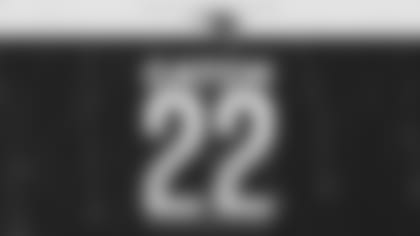HEAD COACH BILL BELICHICK
BB: Alright, how's it going? Buffalo Monday night. That's it.
Q: Before you brought in Kenjon Barner, did he strike you as particularly physical runner for someone under 200 pounds?
BB: He was a good runner, yeah. He's been a good runner, also had some value in the return game. You know, we prepared for him last year, so saw quite a bit of him. He was used offensively, as well as in the return game. So, yeah, he runs hard.
Q: You mentioned that Buffalo uses a lot of defensive players on their coverage unit, and you do as well. How do you balance the roles between guys that are core special teamers and others that do multiple things in other phases of the game?
BB: Yeah, that's a great question, Bob [Socci]. It's one we talk about every week, just trying to find that balance. You know, there are some guys that are on every special team. That's their primary role. There are other guys who are, let's call it, backup or role players but also have a role in the kicking game. And then there are other players who have a bigger role that also have a role in the kicking game. So, it's kind of trying to balance all that out. Sometimes it's who's available, sometimes it's the game plan, sometimes it's the matchup with your opponent that favors one particular guy or a combination of players over another. I'd say, generally speaking, you don't want to give up a big play in the return game, so it's a lot easier, if you will, to put a couple players out there to prevent that from happening rather than give up 50 yards on a return and have him standing there beside you and watch it happen, if you think that will make a difference. So, sometimes that's true in the return the game, too - if it's one or two blocks and you're really worried about it and you need a guy to make that block, even though he might be one of your starting players, if he can make that block, there might be a benefit on the play to make it worth that play. So, every situation is different, each game's different, each player, his role varies from game to game. Some games are tilted more towards a certain type of defense - dime, nickel, base - and offensively, it could be tilted more towards 12, 21, 11, and that would affect the player's role or total role. I think the way you try to look at it is what his total role is. So, if he's going to be out there on every play in an offensive or defensive system - plus it's not just the plays, it's the preparation and all the assignments and everything that - depending on how much you pile on, there's a point where it's probably diminishing returns.
Q: How much variety in personnel in special teams exists beyond the skill players? Do teams have different schemes that they put different groups in, or is it generally the same 11 week-to-week on a play?
BB: Well, it would depend on, Andy [Hart], which phase are you talking about?
Q: Sort of in general. But, like when Dont'a Hightower was out there blocking a punt last week, should a guy on the offensive line have noticed that Hightower wasn't out there the week before? Is there that personnel awareness?
BB: Well, on the punt, punt return game, let's talk about that. On the punt and punt return game, most teams will put out a defensive personnel around midfield - so, let's call it plus-50 punting - to handle any kind of fakes or gadget formations or anything like that. A lot of times you see that same personnel or a part of that same personnel on fourth-and-1 and fourth-and-2 - could be anywhere on the field, backed up. So, if you're concerned about those kind of plays or if a team has a personal protector that's a good runner, or it's a team that's done those type of plays before, then you probably want to keep your defensive guys out there. Some teams just leave their defensive unit out on the field and put in a punt returner - you know, punt safe look - and just make a one-for-one sub with the free safety for the punt returner and play their defense against the punt formation and fair catch the ball. So, I'd say around midfield, that's not that unusual. It certainly changes your punt team or who they're blocking, so it's different blocking a [Akiem] Hicks than it is a receiver that's lined up in there on the punt rush. So, that's a factor. Some teams use bigger guys on the punt team in some situations - you know, one or two. We've done that. A lot of teams do it. Sometimes you do, sometimes you don't, or some teams do it all the time and that way it kind of discourages some of the inside fakes, like the P.P. [personal protector] dive and things like that. If you put a big defensive tackle in there that a linebacker or a tight end is going to have to block, it kind of might discourage them from running the play. So, some teams do that. And on the punt return side of it, you probably want to try to put somebody on a guy that can hold them up and run with them. So, if it's a fast guy, you'd probably put a fast guy on them. If it's a physical guy like Lorenzo Alexander, like I don't think you want to put a 180-pounder on him. He'd just toss them out of the way. So, your matchup on the player that's covering, it's probably a physical matchup that you think is at least competitive. So, sometimes that means juggling guys around. Some teams on kickoff return will take their personnel and they'll just match it to your kickoff team. So, this guy's got that guy. If he lines up at the 3, he lines up at a guard. If he lines up at the 5, he moves in and plays center. If he lines up outside, the guy moves out and plays end - like, that's the guy he's going to block on that play. So, I wouldn't say that's frequent, but it certainly happens. There's some teams that will just match up, like we're going to double-team this guy, we're going to double-team that guy and then you other six guys have these six guys and wherever they are, you line up and block them. If it means mixing the formation up a little bit, they'll do that. Sometimes that happens on punt return, too. If they're going to run right return, they put the guys over here, and left return, they put them over there and have some misdirection to counter it. But, that's basically what they're trying - you know, they'll run eight of those and two of the others to keep you off-balance, but they try to get a matchup that's favorable, then they'll just put them where they want them.
Q: How much flexibility would a guy have to call a timeout? For example, if the right guard notices that something doesn't look right.
BB: On the punt team?
Q: Yes, or in any other phase of special teams? Just for a guy to notice something smells funny and call timeout.
BB: Yeah, well, anytime there's a protection issue, I mean it's no different than the quarterback seeing a blitz that can't be picked up that there's not time to get out of. You never want to run a bad play, so you never want to have a punt blocked. If you see a look that we called this protection and then they moved it or it doesn't look like somebody has the call, to your point, like we're confused here about how to handle a stack or whatever, then always better to take a timeout than to get a punt blocked or to give up a free sack-blitz or that type of play. So, the quarterback of the punt team is the personal protector. That's really his responsibility. Offensively, it's the quarterback. Defensively, it's usually the middle linebacker to the safety. Same thing if they line up in formation and we don't have it - rather than let a bad play happen, just turn around, take a timeout. When you use multiple personnel groups on defense, like regular nickel, dime, or maybe you have two nickels and a dime or two dimes and a nickel. Again, it's pretty common with most teams to have that type of thing. Sometimes the player's not sure if the communication isn't clean or if they sub late - you know, 'Who am I? Because I'm in on all those groups, but in one group I'm a linebacker. In another group, I'm a safety. In another group, I'm a nickel,' let's just say. And then depending on who we have in the game, 'Who am I?' And then we match that to who they have in the game. Sometimes there's a little bit of - there's just communication there to make sure, 'OK, I know I'm the Sam, I know you're the Mike, I know I'm the safety. OK, but with a different grouping, maybe I'm the Mike, somebody else is the Sam and somebody else is the safety. Just who am I?' Once you have that, then I'd say, for the most part, the rest of it usually falls into place. But, if you misidentify the personnel that the offense has on the field - if you think it's 12 and it's 11, or if you think it's 11 and it's 10, or if you think it's 10 and it's 01 - then now the player is thinking, 'Well, here's the match.' But no, it's not what we said it was. So, that's all real football. That's what football is. Those things happen, so you have to adjust to them.
Q: Is that a balance to make sure? Obviously, sometimes more personnel groupings can be better because you can get different players in at times, but if you have too many, they've got too many options or questions?
BB: Look, nothing's a good idea if you can't execute it. You can put together any kind of bridge you want. If you can't build it, then it's going to fall down. It's the same thing you've got to - if you can't do it, then you're probably better off not doing it. Now sometimes, you think you can do it and something happens and it doesn't turn out that way. But, if you feel like you can execute it, then great. If you feel like you can't execute it, then I think you're usually better off throwing it out and doing something you can at least do.
Q: Yesterday was the two-year anniversary of the day Kyle Van Noy was traded here. He said that coming here changed his career. How has he evolved in the two years you've been coaching him?
BB: Well, yeah, anytime you get a player that you haven't had before, it takes you a little while to get to know the player and find out how he thinks, what skills he's good at and what positions he can play and so forth. Kyle has turned out to be very versatile and very good at many things we've asked him to do, from the kicking game, to playing on the line of scrimmage, to playing off the line of scrimmage, to blitzing, to playing man coverage, zone coverage - so, multiple things. So, we didn't know that. Some of it was kind of a step-by-step process. A couple times we were forced into a situation because he is big, he is athletic, he is smart, he does have good football instincts, so a lot of times he just does the right thing on something that maybe we haven't gone over or hasn't specifically been covered. He just does what he thinks is right in that situation, like [Patrick] Chung would do, like [Devin] McCourty would do. Like a lot of good football players, they just know what to do. And I would say he's one of those - Hightower, those guys - sometimes they get in a situation that we haven't really covered this, and they just do the right thing because they're just good, instinctive players. So, Kyle's shown to be all that, plus he's given us good depth in the kicking game. Again, not that he's out there for every play in the kicking game, but he's responsible for a lot of things, so if something happened and we needed him, he would be ready to go. And that's, when you're a head coach or a special teams coach, that's a comforting feeling. Even though the guy's not out there for 30 plays in the kicking game, the fact that you know you have somebody dependable to put in that spot if it comes up is a lot better than having to worry about 66 spots and if one thing happens, like 'oh my god, what are going to do?' You need players like Kyle and Pat, Hightower, James White, guys like that, Dwayne Allen, [Chris] Hogan, that can just step in there and do it. So yeah, we talked about it yesterday. It's seems like it's gone fast and he's played here 10 years. But, yeah, he's certainly been in a lot of roles for us, done them well and has given us great communication and leadership on and off the field.
Q: It seems like Stephon Gilmore has been getting his hand on the ball a lot in coverage. Is that a skillset he's always had, or have you seen that improve over the last couple years that you've had him?
BB: Well, I think - again, he was a good player in Buffalo, obviously, and has done a good job for us. I think he's continued to improve for us as he's gotten more familiar with our scheme, and also I think we were able to utilize him in ways that are more advantageous to him. And so, again, part of the same thing we talked about with Kyle, the longer you're with a player, you understand things that he does well, that he's comfortable with, and maybe some things, situations that you'd rather leave him out of because there's a better way to do it - not that he can't do it, but just whatever the best way is. Ultimately, that's what you want to try to get to, as long as it fits in with everything else. So, I think as he and Pat, Devin, Jon [Jones], Duron [Harmon], those guys have played together more, there's just a comfort level in those type of adjustments. But, yeah, he gets his hands on a lot of balls in practice. So, he's playing with a lot of confidence, playing with good technique and just the second year has helped, like it usually does with most players.
Q: Can more breakups like that come once a player does get more used to the technique that you guys are teaching?
BB: Hopefully, yeah. I mean, I hope so. That's why we're out there every day. I mean, you'd like to think so, yeah.
Transcripts are provided by the Patriots media relations department as a courtesy to the media and are edited for readability. All press conferences are posted and archived in their entirety at patriots.com.









































